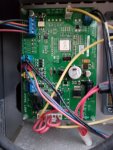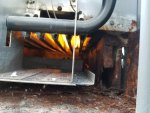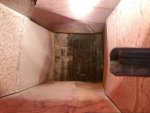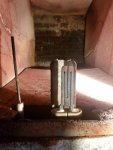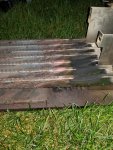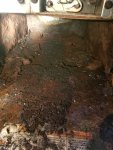I've had a Jandy Legacy LRZ175EN gas heater since ~ 2013. [If this is the expected life of this heater, stop reading and let me know.] Last night, it started throwing up "FAULT - CHECK IGN CONTROL" It usually does this at the start of the season when there may be air in the line (?), and I can usually just cycle through to get rid of the error and move on. Not so this time. The heater cycles through 3 times then throws the error up.
I'm having trouble searching TFP for some reason, so all I can do is a Google search. I'm sure there's lots of good information, but there's also lots of unrelated information that I cannot filter out effectively.
Looking at the flame picture, you can see significant rust (flaking and holes) at the bottom right). While taking panels off to see what was under them, I discovered that the back-side plug (maybe for measuring internal temperature) was dripping and had caused significant rust as well. I don't know what defines the firebox, and what is outside it. If you could guide me to that end, I could disassemble to there to inspect it for integrity / condition.
I've probed around for voltages. Supply is 28.8 VAC. The blue connector top left has BK = 0, ) = 4.7 VAC, BL = 4.7 VAC, and R = 21.3 VAC. The 2-pin connectors to the left (blue, red, and yellow) are labeled HIPres HiLimit, LowPres FuseLink, and Water Pres respectively. I don't measure anything on them at any time. From Google search, I was looking for a thermocouple, but I couldn't find it.
I'm having trouble searching TFP for some reason, so all I can do is a Google search. I'm sure there's lots of good information, but there's also lots of unrelated information that I cannot filter out effectively.
Looking at the flame picture, you can see significant rust (flaking and holes) at the bottom right). While taking panels off to see what was under them, I discovered that the back-side plug (maybe for measuring internal temperature) was dripping and had caused significant rust as well. I don't know what defines the firebox, and what is outside it. If you could guide me to that end, I could disassemble to there to inspect it for integrity / condition.
I've probed around for voltages. Supply is 28.8 VAC. The blue connector top left has BK = 0, ) = 4.7 VAC, BL = 4.7 VAC, and R = 21.3 VAC. The 2-pin connectors to the left (blue, red, and yellow) are labeled HIPres HiLimit, LowPres FuseLink, and Water Pres respectively. I don't measure anything on them at any time. From Google search, I was looking for a thermocouple, but I couldn't find it.



